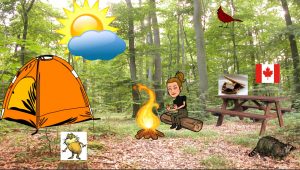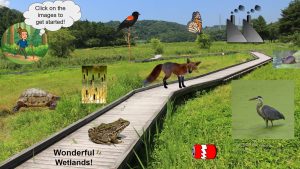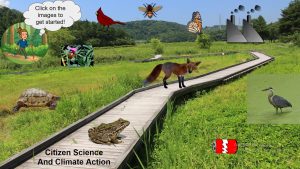Outdoor Virtual Classroom Choice Boards

To view the photo-rich magazine version, click here.
Originally appears in the Summer 2020 issue.
By Jennifer Baron
In past years, I’ve preferred taking my students outside for learning as often as possible, especially in the spring. This year, however, the emergency response to the COVID-19 pandemic drastically changed that plan. Like so many educators, I had to adapt quickly to teaching and learning from home. One of the most intriguing software applications I have discovered is the virtual classroom, sometimes called a choice board. [Insert image of choice board] You maybe started to see these pop up as teachers collectively experimented with new applications. Indeed, virtual classrooms quickly become the norm. Yet, I wanted to take the experience beyond the boundaries of the classroom setting for my homeroom and Rotary Science classes, just as I would do if we were in school. So, I created outdoor virtual classroom choice boards that aligned with the safety and emergency protocols for remote, at-home, online learning during the pandemic. I have received feedback from K–12 teachers and students that these types of virtual classrooms appeal to their senses of creativity and choice, which has led to higher levels of engagement in their learning.
Here is a very quick how-to guide for creating them:
- Start a Google Slide. Change the background theme to an outdoor setting like a forest or wetland. Insert images that match your theme, such as plants or animals.
- Search the web for resources that connect to the curriculum you are teaching and highlight their URL addresses. Insert each of these resource links onto the applicable corresponding images.
- Download the Bitmoji extension. It will then appear on your toolbar. Decide on a Bitmoji that matches your theme.
Place a speech bubble with very basic instructions next to your Bitmoji avatar (a personalized cartoon character). If you prefer to include video instructions, you could add the video link to the speech bubble. This could allow you to communicate more complex ideas and instructions remotely. - Repeat this process and balance the visuals around the page until you are happy with the results.
- Share the page with your students!
For a more detailed, step-by-step tutorial, there are many free Youtube videos that go into greater depth and have added steps which you might like to add.

Figure 1
Benefits
There are many benefits to using virtual classroom choice boards. They allow for embedding differentiated instruction. By their very nature, they appeal to visual learners. The resources can connect to kinesthetic skills, such as building things like homemade birdfeeders as well as body breaks. Videos and music support your auditory learners. You could try adding images with links to resources and tasks that relate to each of Howard Gardner’s Multiple Intelligences: musical, spatial, logical-mathematical, intra-personal, linguistic, interpersonal, existential, and naturalistic.
As a Primary- and Junior-level teacher, I have found that images and links to resources intuitively lead early readers through the instructions of what I want them to learn. They also have the choice about the order of what they will learn. Images tend to pique my students’ curiosity more than the average PDF worksheet, leading to a higher level of engagement. You can create a dynamic virtual classroom with a variety of ideas from which students have the power to choose.
From a pedagogical perspective, outdoor virtual classroom choice boards can comprise the key tenets of environmental education. They can integrate subjects, be place-based, spark inquiry, and demonstrate systems thinking. One thing we have learned without a doubt from this coronavirus pandemic is that we are an intricately interconnected planet. Thus, it helps to harness systems thinking and interconnectedness in order to visualize how to design an outdoor virtual classroom.
Although we would not have chosen to be in the remote learning situation en masse this spring, it has forced us outside our comfortable boundaries in teaching. Outdoor virtual classroom choice boards move us well beyond the worksheet. We can integrate a variety of digital applications, such as read-alouds, short videos, games, and quizzes to create a dynamic learning environment. Students can also generate new thinking and share their ways of knowing using embedded links via such tools as Google Docs, Slides, and Forms; Padlet; Kahoot; and Jamboard, to name just a few. The list seems to grow every day! These tools ensure that the tasks you are assigning help students communicate their new learning rather than simply keep them busy.

Figure 2
Additional appeal
One of the things I particularly appreciate about outdoor virtual classroom choice boards is their capacity for including multiple starting points. Figures 1 and 2 illustrate two outdoor classrooms I created with a wetland theme. The first, “Wonderful Wetlands,” includes links for my Grades 1–4 Science classes, covering plants and animals in wetland ecosystems. There are short videos about types of wetlands, a frog video game, a how-to-build-a-bird-feeder activity, and a Google Form quiz that starts when students click on the fox. (I know they love foxes, so they will click on it!) The second was designed using the same images, but in this virtual class, the links are to Citizen Science and Climate Action projects and initiatives. The information in these links is better suited for students in Grades 4–12. These initiatives and projects can inspire environmental action starting at home! Teachers are finding ways to connect such lessons to environmental action programs like EcoSchools as well.
Some may think outdoor classroom virtual choice boards are too “simple” for high school students. I disagree because the dynamic energy and visual images appeal to older students as well! To support this conclusion, I have surveyed my own students as well as teachers in my Professional Learning Network (K–12 educators from across Ontario), and they agree that the diversity of choice and dynamic resources make these platforms engaging entry points for online learning across divisions and subjects.
As the return to school date was continuously pushed back throughout the spring, I sensed that teachers and my students needed an injection of creative energy, and I discovered that free virtual field trips captured their attention. This motivated me to begin designing outdoor virtual choice boards around the theme of virtual field trip experiences. Despite the many challenges with the current situation in which we find ourselves with COVID-19, the experience of teaching and learning remotely made me realize that I could introduce my students to international environments through the internet! I simply asked my students where they wanted to go and they had no shortage of ideas. Here are our top ten requested virtual themes and field trips:
- farm
- aquarium
- outer space
- zoo
- wetland
- ocean
- community garden
- dinosaurs
- amusement park
- camping
I could write an entire article on links to free virtual field trips, but there are a tonne out there that are easy to discover with a quick search on the web.
Links include free virtual field trips at aquariums and a tour of the Titanic via Google Earth, where the treasure chest includes a quiz!
Sometimes a distraction from life on Earth is exactly what students need to escape their current frustrations. There are wonderful resources to support your students’ inquiry and research about Mars (pictured in Figure 3), for example. And this may help them appreciate living on our planet just a little bit more.
Where to next?
Where can more ideas be found? I’m inspired by the big ideas in the Ontario curriculum, input from my Professional Learning Network, and my students’ feedback. I also look for free programs that have been approved for use by my Board, York Region District School Board. Approved platforms have teacher dashboards, including GetEpic for reading, Prodigy for Math, and GoNoodle for body breaks.
My students shared their favourite parts of our outdoor classroom virtual choice boards with me via Google Forms and our synchronous chats on Google Meet. They said that they liked, in no particular order, links to games, videos, learning about a particular topic, and, surprisingly, perhaps, quizzes. I often used the multiple choice function in Google Forms. The data returned from their collated responses is helpful as well as enjoyable to read. At the end, I include questions that evoke deeper thinking and require a short reflective answer. These questions help me to assess their knowledge and feelings, while also providing me with feedback to orient me towards next steps. Examples of these types of questions could be as follows: What did you find the most interesting? What questions came up for you? What would you like to learn more about? Your students’ responses will help in the creation of better outdoor classroom virtual choice boards which connect to their personal experiences and real-time contexts.
Many parks are open for day use, but may remain closed for camping in various parts of North America. Educators and families could use this camping-at-home choice board (Figure 4) for virtual camping this summer. It includes campfire songs, a smores-in-the-kitchen recipe, games, instructions on how to make a blanket fort in the living room, camping stories, and videos.
Visit this address on Teachers Pay Teachers to access a free copy as well as live links to other Outdoor & Environmental Virtual Classrooms & Choice Boards.

Figure 3
Come September…
This summer, educators will continue to discuss what learning will look like in September. I hope that outdoor virtual classroom choice boards will inspire decision-makers to look to real outdoor learning as a way to ease the transition back to school. If teachers remain flexible and apply a blended approach of in-school and virtual learning, outdoor virtual choice boards can be useful assets. Choosing a theme related to being outside can assist with mental health, as research shows that being in nature calms our anxiety and helps us focus.1 After so much time spent indoors, children will be craving the opportunity to go outside. My own students light up in our online chats when they tell me about the times they have spent playing outside! Finally, promoting outdoor learning exemplifies how to be brave. It will be hard for many to get back to school and even harder to take the learning outside. I once taught at an outdoor education center for my Board on 9/11. For days, the planes overhead stopped. Immediately after, we grew into a culture built on fear. Barriers to outdoor education seemed to spring up everywhere. It took years for movements like “risky play” and Forest Schools to gain ground in mainstream education.2 Although it may seem difficult to integrate outdoor education into classroom learning going ahead, there is an opportunity to demonstrate that outdoor education has the capacity to offer the space needed for physical distancing3 and promotes mental and emotional health.4 Moving forward, I encourage outdoor and environmental educators to be a part of the ongoing discussions about how to embrace this opportunity safely, cautiously, and bravely.
Many people have asked me what I think September will look like — what the plan will be. I think there will be multiple plans followed by multiple multi-tiered contingency plans. I recently heard this quote in passing; it is very timely: “If Plan A doesn’t work, thank goodness the alphabet has 25 more letters!”. For what it’s worth, I believe there will be a blend of learning at school and online. We were headed that way before the pandemic, and COVID-19 gave us the push to enact such a strategy further. We may start out at school and then there could be locations that need to return for a time to online learning. The way to adapt is through flexibility and an optimistic approach to the software and educational tools available to us. Making virtual classrooms can be a wonderful way to channel creative energy. It can be very addictive, however, so please take your students and the learning outside when it has been deemed safe to do so.
In closing, I must thank my students and fellow educators for their feedback on outdoor virtual classrooms and choice boards. It is my hope that this article will help promote the possibilities of outdoor education and student engagement both in nature and online.
Jennifer Baron has written and taught Environmental and Outdoor Education Additional Qualification courses for Nipissing University, York University, and (currently) the Elementary Teachers’ Federation of Ontario. She taught at Sibbald Point and Vivian Outdoor Education Centre for York Region District School Board. In 2018, Jen received Natural Curiosity’s Edward Burtynsky Award for Excellence in Environmental Education. Jen has been an Elementary Teacher for 25 years with YRDSB. She has an Honours Degree in Environmental Studies and Indigenous Studies from Trent University.
Endnotes:
- Forman, Moshe. 2020. “Nature Can Cure Overthinking, According to Science.” Introvert, Dear. (https://introvertdear.com/news/nature-can-cure-overthinking-according-to-science/)
- Harper, Nevin J. 2017. “Outdoor risky play and healthy child development in the shadow of the ‘risk society’: A forest and nature school perspective.” Child & Youth Services, 38(1):00-00. https://doi.org/10.1080/0145935X.2017.1412825.
- Last, John. 2020. “Why on-the-land educators see opportunity in a global pandemic,” CBC News, May 19. (https://www.cbc.ca/news/canada/north/on-the-land-education-covid-19-1.5571602)
- Frumkin, Howard., Gregory N. Bratman, Sara J. Breslow, Bobby Cochran, Peter H. Kahn Jr., Joshua J. Lawler, Phillip S. Levin, Pooja S. Tandon, Usha Varanasi, Kathleen L. Wolf, and Spencer A. Wood. 2017. “Nature Contact and Human Health: A Research Agenda.” Environmental Health Perspectives, 2017 Jul; 125(7). https://doi.org/10.1289/EHP1663.










